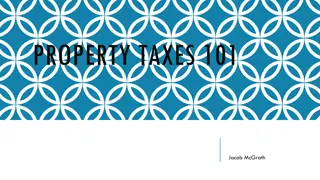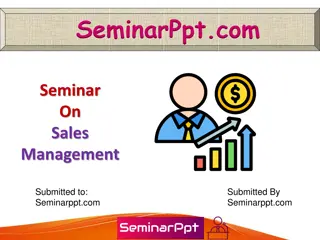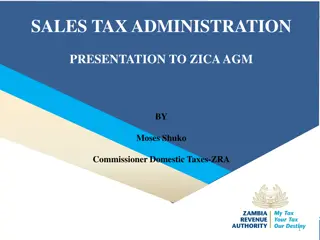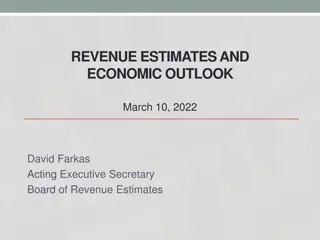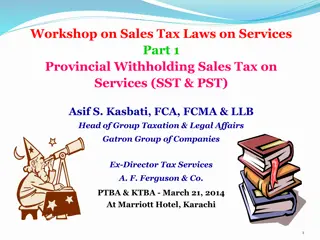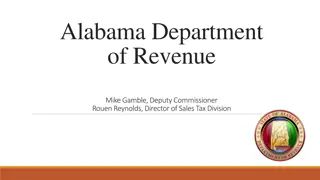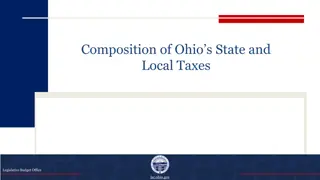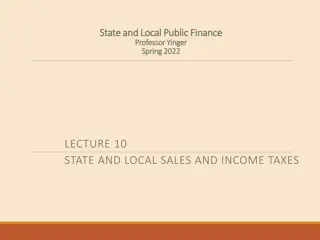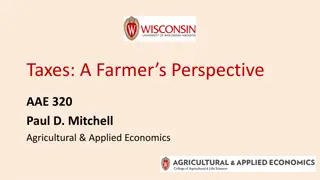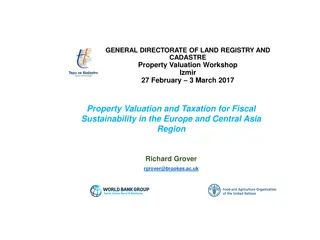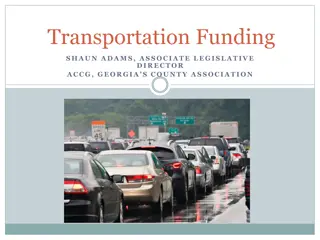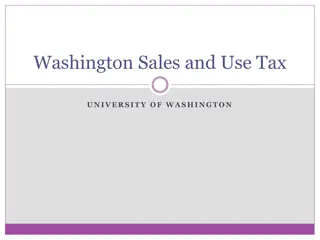Sales Taxes: Key Concepts and Implications
Sales taxes play a crucial role in public finance, affecting equity, efficiency, and tax distortion. Explore the basics of sales tax administration, tax incidence, and recent research findings. Delve into the impact of landmark legal decisions on the design and collection of sales taxes, shedding light on the complexities and implications for businesses and states.
Download Presentation

Please find below an Image/Link to download the presentation.
The content on the website is provided AS IS for your information and personal use only. It may not be sold, licensed, or shared on other websites without obtaining consent from the author.If you encounter any issues during the download, it is possible that the publisher has removed the file from their server.
You are allowed to download the files provided on this website for personal or commercial use, subject to the condition that they are used lawfully. All files are the property of their respective owners.
The content on the website is provided AS IS for your information and personal use only. It may not be sold, licensed, or shared on other websites without obtaining consent from the author.
E N D
Presentation Transcript
PUBLIC FINANCE SEMINAR PUBLIC FINANCE SEMINAR SPRING 2021, PROFESSOR YINGER SPRING 2021, PROFESSOR YINGER Sales Taxes Sales Taxes
Sales Taxes Sales Taxes Class Outline Class Outline Administration of the Sales Tax Tax Incidence (Equity) Tax Distortion (Efficiency) Recent Research on the Sales Tax
Sales Taxes Sales Taxes The Basics The Basics The sales tax is really a sales and use sales and use tax. States levy a tax on the purchase or use of a commodity or service within their boundaries. States cannot levy a tax on the purchase or use of a commodity in another state. What counts is point of delivery. delivery. So wine shipped from one state to another is taxed where it is delivered. The use tax is hard to administer: Massachusetts police parked at New Hampshire liquor stores. Interstate agreements to share credit card information for large purchases in one state delivered to another without collection of sales taxes (unless the new Supreme Court decision is applied to these sales).
Sales Taxes Sales Taxes A Key Administrative Issue In The Design Of A Sales Tax According to the 1992 Quill decision by the U.S. Supreme Court, sales taxes on mail order or internet sales could only be collected if the seller has a business nexus in a state. o This decision was based on the inter-state commerce clause of the U.S. Constitution, which prohibits one state from placing an undue burden on businesses in other states. o It cost the states billions of dollars and was a major source of distortion. This decision was overturned in June 2018 by the Wayfair decision. o This decision applied directly to South Dakota, but set up rules that other states could use to tax mail order or internet sales.
Sales Taxes Sales Taxes A Key Administrative Issue In The Design Of A Sales Tax, 2 In response to the Quill decision, many states joined an interstate compact to create uniform definitions and rates for state sales taxes. These steps lowered the burden of collecting the sales tax, which was the basis of the Quill decision and hence led to Wayfair. In addition, New York won a case arguing that Amazon had to collect taxes for New York customers because they had affiliates (economic nexus) in New York, even though it did not have offices in New York (physical nexus). By the way, Amazon eventually realized that it might as well have physical nexus, at least in big states, because this step could increase delivery speeds, which customers value. The principles in the Wayfair decision apply to many states. It is not clear, however, what will happen in states with complicated sales tax provisions, such as different product definitions at the state and local levels.
Sales Taxes Sales Taxes Tax Incidence Tax Incidence Tax incidence has two meanings. Legal incidence Legal incidence is about who has the legal obligation to pay a tax. With a sales tax, this is usually the seller. This is the meaning relevant for administration. Economic incidence Economic incidence is about whose opportunities are constrained by a tax, that is, who bears the burden. This is the meaning relevant for evaluating the fairness of a tax.
Sales Taxes Sales Taxes Market Analysis Market Analysis Standard incidence analysis begins by looking at the impact of a tax on the market for the taxed good or goods. This analysis does not apply to the market for one taxed good if other goods are being taxed, too. This analysis is based on relative prices, which do not change for two goods that are both taxed
Sales Taxes Sales Taxes Market Analysis, 2 Market Analysis, 2 Possibility 1: Consumers Pay D P P S+tax S+tax P2 S+tax S+tax P2 S P1=P3 P1=P3 S D Q Q
Sales Taxes Sales Taxes Market Analysis, 3 Market Analysis, 3 Possibility 2: Firms Pay S+tax S S P P P1=P2 P1=P2 D tax tax tax tax P3 P3 D Q Q
Sales Taxes Sales Taxes Market Analysis, 4 Market Analysis, 4 Possibility 3: The burden is shared. P S+tax S P2 tax tax Burden on consumers Burden on consumers P1 Burden on firms Burden on firms P3 D Q
Sales Taxes Sales Taxes A Simple Model of Incidence A Simple Model of Incidence Now consider the simplest possible supply and demand equations: = + ( ) Q a b P T s S S and = Q a b P D D D Since QSmust equal QD in equilibrium, we can equate the two right sides and solve for P: + a a b T = D S + S P b b D S
Sales Taxes Sales Taxes Shifting Shifting Now we can take the derivative of P with respect to T; i.e., we can ask how P changes as Tchanges. From this it is clear that b + 1 dP dT = = S b b b b + 1 D D S S 1 2 dP dT = = if = then half shifted b b D S dP dT = = if = then 0 not shifted at all b D dP dT = 1 fully shifted = = if then b S
Sales Taxes Sales Taxes Shifting, 2 Shifting, 2 This simple example refers to slopes. A more general version would refer to price elasticities. The degree of shifting depends on the relative price elasticities of demand and supply (in absolute value). The intuition is about responsiveness. A more responsive curve, which suggests more alternatives, implies that a side of the market is better able to escape the tax. Do firms have alternative products to provide? Do consumers have alternative products to consume?
Sales Taxes Sales Taxes Incidence, 2 Incidence, 2nd nd Step Step The second step is to translate to the distribution of income. This obviously depends on the incomes of suppliers versus demanders. Either one could be higher. The result is usually summarized with a graph with T/Y on the vertical axis and Y on the horizontal axis. A flat curve indicates a proportional system; a rising curve indicates a progressive progressive system, and a falling curve indicates a regressive regressive system. proportional
Sales Taxes Sales Taxes Incidence by Income Incidence by Income In a graph, these concepts are: T Y Progressive Progressive Proportional Proportional Regressive Regressive Y
Sales Taxes Sales Taxes Equity Principles Equity Principles In a policy setting, the positive analysis of tax incidence is combined with judgments about what is fair. The ability to pay ability to pay principle says that people with a higher income should pay at least the same share of their income in taxes as people with a lower income. People may disagree, of course, about how much progressivity is desirable. Proportionality can be thought of as the lower bound on tax distributions consistent with this principle. The benefit principle benefit principle says that people who benefit from the funded service should pay, but this does not rule out progressivity within this set of people.
Sales Taxes Sales Taxes Tax Distortion Tax Distortion Taxes affect behavior. This implies that taxes move outcomes away from the efficient level that is generated by a competitive private market (under some circumstances) i.e. that taxes cause distortion. As before, the basic analysis applies to taxed markets relative to untaxed markets not to one of many taxed markets.
Sales Taxes Sales Taxes Excess Burden Excess Burden Consider an elastic supply curve. The initial equilibrium is (P1, Q1). Because the tax is fully shifted, the new price, P2, equals P1(1+t), or P = tP1. Now if we draw the picture, we see that consumer surplus drops because of the tax revenue that is collected and because of a lost triangle = excess burden = deadweight loss excess burden = deadweight loss.
Sales Taxes Sales Taxes Excess Burden, 2 Excess Burden, 2 In a graph: Government Revenue Government Revenue P Excess Burden Excess Burden P2 S+tax S+tax P = t P1 S Q D Q2 Q1 Q The Market for Taxed Goods The Market for Taxed Goods
Sales Taxes Sales Taxes Excess Burden, 3 Excess Burden, 3 We do not consider the tax revenue as a loss of consumer surplus. Tax analysis usually compares the burden from alternative taxes, so this revenue will be lost no matter what we do. Moreover, even if we were just evaluating a single possibility, the revenue collected presumably results in benefits in the form of public services. The triangle, called distortion or excess burden or EB, equals ( ) Q P = (1/2) Q(tP1).
Sales Taxes Sales Taxes Excess Burden, 4 Excess Burden, 4 Now the absolute value of the price elasticity of demand, say e, equals (P1 Q)/(Q1 P). So Q = (eQ1)( P/P1) = (eQ1)(tP1)/P1 = (eQ1)t and EB= (e)(t2)(P1Q1) This is a central result in tax analysis. Remember it!
Sales Taxes Sales Taxes Excess Burden, 5 Excess Burden, 5 This result yields three important lessons in here: 1. EB increases with the size of the market being taxed (PQ). 2. EB increases with the price elasticity of demand. Lesson: tax products with a low price elasticity that leads to minimal distortion (but may not lead to greatest fairness!). 3. EB increases with the square of the tax rate. The lesson: Have a diversified revenue system.
Sales Taxes Sales Taxes Excess Burden, 6 Excess Burden, 6 Why excess burden increases with the absolute value of the demand elasticity: P P P2 P2 S+t S+t S+t S+t P1 S D P1 S D Q Q Q Q Q Q Q 2 1 2 1 Large elasticity ( e ) = Responsive Demand Small Elasticity ( e ) = Unresponsive Demand
Sales Taxes Sales Taxes Excess Burden, 7 Excess Burden, 7 Why the square of t? P P3 S+(2 S+(2 t) t) P2 S+t S+t P1 S D Q3 Q2 Q1 Q
Sales Taxes Sales Taxes Excess Burden, 7 Excess Burden, 7 An additional important result arises in a market with an externality. An example is the market for gasoline. People buy gasoline in order to drive, and when they drive, they cause highway deterioration, pollution, and congestion. Generally, gas taxes are set to cover maintenance only. Raising the tax further would actually reduce distortion (i.e. lower excess burden).
Sales Taxes Sales Taxes Excess Burden, 9 Excess Burden, 9 Excess Burden with an Externality Government Revenue Government Revenue P Excess Burden Excess Burden Avoided with Tax = SMC with Tax = SMC Avoided P2 S + Tax = S + Tax = PMC+SMC PMC+SMC P = t P1 S = PMC Q D Q2 Q1 Q The Market for Taxed Goods The Market for Taxed Goods
Sales Taxes Sales Taxes Recent Literature on Sales Tax Shifting Recent Literature on Sales Tax Shifting Several recent studies regress P on T in some form or another to see if P goes up dollar for dollar with T. Poterba (one of the stars of empirical public finance, an economist at MIT) does this for a few broad categories of goods in a few cities and finds approximately full forward shifting onto consumers. Besley and Rosen (two more stars; one a former editor of the American Economic Review, the other the author of a popular public finance textbook) conduct this analysis for many narrow categories of goods and find overshifting.
Sales Taxes Sales Taxes Terminology Terminology This research is a bit hard to get into because of terminology. Start with a tax rate of t. The key is to distinguish between marginal cost (MC), the price inclusive of tax (Q), and the price exclusive of tax (P). The price inclusive of tax is what one observes in a market once the tax is imposed. The price exclusive of tax is what the firm receives. So with no taxes and competitive markets, P=Q=MC. With taxes, competitive markets, and full shifting: Q = P(1+t) = MC(1+t).
Sales Taxes Sales Taxes Poterba ( Poterba (NTJ NTJ 1996) 1996) The Poterba approach is to regress Q on national price changes and local taxes. In city i: Qi = QUS(1+ti) or ln(Qi) = ln(QUS) + ln(1+t) ln(MC) + t Poterba estimates this equation in change form. He also uses seemingly unrelated regression technique to account for correlations across cities.
Sales Taxes Sales Taxes Poterba 2 Poterba 2 With this specification, full shifting exists if the value of is 1.0. A value above 1.0 indicates over-shifting. How could there be over-shifting? The most plausible explanation is market power. With an elastic demand curve, a monopolist will raise the price by more than the tax.
Sales Taxes Sales Taxes Poterba s Poterba s Results Results Poterba uses data on categories of spending, namely, women s and girl s clothing, men s and boys clothing, and personal care items. One data set is for 1947-77, another is for 1925-39. He finds full shifting. Because the model is specified in difference form, the dependent variable is the percent change in the price for a spending category in a city and the key explanatory variable is the change in the city s sales tax rate. He has lagged values to pick up the phase-in of tax effects and finds small but significant lagged impacts. The total impacts imply full shifting.
Sales Taxes Sales Taxes Besley Besley/Rosen ( /Rosen (NTJ NTJ 1999) 1999) The Besley/Rosen approach is to take market prices, Q, divide by (1+t) to get P, and regress P on t. With full shifting, the coefficient of t will be zero: Q/(1+t) = P = MC or, in regression form, P = MC + t The predicted value of is zero; a value above zero indicates overshifting onto consumers.
Sales Taxes Sales Taxes Besley Besley/Rosen Results /Rosen Results They use data for the last 30 years for specific products (a Big Mac, a box of Kleenex, a Monopoly game, and a package of 3 boys cotton briefs.) Their regressions include city and time effects and measures of real rental, wage, and energy costs to capture MC. The find full shifting for some (including Monopoly, Big Macs, and Kleenex) and over-shifting for others. They also do some dynamic analysis and find that the impact of taxes shows up very rapidly. They also reject Poterba s differencing approach.
Sales Taxes Sales Taxes Young and Young and Bielinska Bielinska- -Kwapisz Kwapisz This paper is in the NTJ in 2002. They find over-shifting of excise taxes on beer and wine. So taxes are shifted and there is considerable evidence for market power!
Sales Taxes Sales Taxes Hawkins Hawkins Finally, Hawkins, (NTJ, December 2002) provides some interesting results on the distortion caused by various forms of the sales tax. Hawkins estimates a demand system for all broad categories of consumption (nondurables, services, alcohol, gasoline, tobacco, home food, utilities, and autos and furnishings). This is done by assuming a pretty general functional form that yields structural parameters, that is, the parameters of the underlying utility functions which makes it possible to calculate the EB from various forms of the sales tax. He looks at 8 cases. The base case has no exemptions and no taxation of business inputs (which he calls pyramiding). The other cases add exemptions and/or taxation of (non- exempted) inputs: Here they are, with the excess burden that results (as a percent of revenue raised):
Sales Taxes Sales Taxes Hawkins s Results Hawkins s Results Case Case 1. Base 1. Base 2. Services + home food 2. Services + home food Excess Burden Excess Burden -- -- 23.3% 23.3% 3. Case 2 + utilities 3. Case 2 + utilities 4. Case 3 + Gasoline 4. Case 3 + Gasoline 5. Base + 5. Base + Pyramiding Pyramiding 30.6% 30.6% 38.5% 38.5% 0.4% 0.4% 6. Case 2 + 6. Case 2 + Pyramiding Pyramiding 17.9% 17.9% 7. Case 3 + 7. Case 3 + Pyramiding Pyramiding 22.1% 22.1% 8. Case 4 + 8. Case 4 + Pyramiding Pyramiding 26.7% 26.7%
Sales Taxes Sales Taxes Lessons from Hawkins Lessons from Hawkins The exemptions do cause excess burden, as expected. Services and home food, which are usually exempted, have a significant burden. The equity gains must be worth it! Adding pyramiding actually lowers EB (except in case 5)! This is a surprise. But it happens because the taxed inputs produce goods that have inelastic demands and that tend to be exempt themselves. So ironically, pyramiding actually boosts efficiency by indirectly taxing exempt goods!


